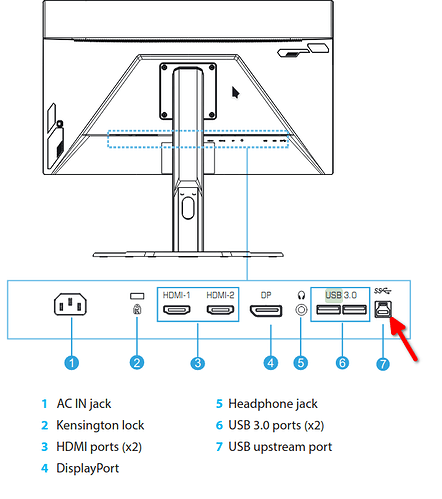Hello. I am new to Linux and have been using Garuda Linux (KDE Dragonized Gaming version) on my desktop computer for around two months now.
I am using a 'JBL Quantum 400' headset connected to my monitor and through display port to my computer. Audio output works fine with the headset but I cannot get the microphone to work.
I have primarily tried with discord but it did not work in any other situation either such as mic testing websites. The input device detected by applications is called 'alsa_output.pci-0000_0b_00.4.iec958-stereo.monitor' and this device plays back all system output, but does not play anything from the microphone.
I know my microphone and monitor are functional, as using them with my windows laptop has worked fine.
System:
Kernel: 5.16.5-zen1-1-zen x86_64 bits: 64 compiler: gcc v: 11.1.0
parameters: BOOT_IMAGE=/@/boot/vmlinuz-linux-zen
root=UUID=7dad8b1e-d496-4253-b075-eb6863dfeb33 rw rootflags=subvol=@
quiet splash rd.udev.log_priority=3 vt.global_cursor_default=0 loglevel=3
Desktop: KDE Plasma 5.23.5 tk: Qt 5.15.2 info: latte-dock wm: kwin_x11
vt: 1 dm: SDDM Distro: Garuda Linux base: Arch Linux
Machine:
Type: Desktop System: ASUS product: N/A v: N/A serial: <superuser required>
Mobo: ASUSTeK model: ROG STRIX B550-F GAMING (WI-FI) v: Rev X.0x
serial: <superuser required> UEFI: American Megatrends v: 2006
date: 03/19/2021
Battery:
ID-1: hidpp_battery_0 charge: 37% condition: N/A volts: 3.8 min: N/A
model: Logitech G502 LIGHTSPEED Wireless Gaming Mouse type: N/A
serial: <filter> status: Discharging
CPU:
Info: model: AMD Ryzen 7 5800X bits: 64 type: MT MCP arch: Zen 3
family: 0x19 (25) model-id: 0x21 (33) stepping: 0 microcode: 0xA201009
Topology: cpus: 1x cores: 8 tpc: 2 threads: 16 smt: enabled cache:
L1: 512 KiB desc: d-8x32 KiB; i-8x32 KiB L2: 4 MiB desc: 8x512 KiB
L3: 32 MiB desc: 1x32 MiB
Speed (MHz): avg: 3838 high: 4632 min/max: 2200/4850 boost: enabled
scaling: driver: acpi-cpufreq governor: performance cores: 1: 3706 2: 3694
3: 3691 4: 3752 5: 4507 6: 3724 7: 3698 8: 3730 9: 3852 10: 3702 11: 3764
12: 3824 13: 4632 14: 3676 15: 3707 16: 3752 bogomips: 121377
Flags: avx avx2 ht lm nx pae sse sse2 sse3 sse4_1 sse4_2 sse4a ssse3 svm
Vulnerabilities:
Type: itlb_multihit status: Not affected
Type: l1tf status: Not affected
Type: mds status: Not affected
Type: meltdown status: Not affected
Type: spec_store_bypass
mitigation: Speculative Store Bypass disabled via prctl
Type: spectre_v1
mitigation: usercopy/swapgs barriers and __user pointer sanitization
Type: spectre_v2 mitigation: Full AMD retpoline, IBPB: conditional,
IBRS_FW, STIBP: always-on, RSB filling
Type: srbds status: Not affected
Type: tsx_async_abort status: Not affected
Graphics:
Device-1: AMD Navi 21 [Radeon RX 6800/6800 XT / 6900 XT] vendor: ASUSTeK
driver: amdgpu v: kernel bus-ID: 09:00.0 chip-ID: 1002:73bf class-ID: 0300
Display: x11 server: X.Org 1.21.1.3 compositor: kwin_x11 driver:
loaded: amdgpu,ati unloaded: modesetting,radeon alternate: fbdev,vesa
display-ID: :0 screens: 1
Screen-1: 0 s-res: 4480x1440 s-dpi: 96 s-size: 1185x381mm (46.7x15.0")
s-diag: 1245mm (49")
Monitor-1: DisplayPort-0 res: 1920x1080 hz: 60 dpi: 82
size: 598x336mm (23.5x13.2") diag: 686mm (27")
Monitor-2: DisplayPort-2 res: 2560x1440 hz: 165 dpi: 109
size: 597x336mm (23.5x13.2") diag: 685mm (27")
OpenGL: renderer: AMD Radeon RX 6800 (SIENNA_CICHLID DRM 3.44.0
5.16.5-zen1-1-zen LLVM 13.0.0)
v: 4.6 Mesa 21.3.5 direct render: Yes
Audio:
Device-1: AMD Navi 21 HDMI Audio [Radeon RX 6800/6800 XT / 6900 XT]
driver: snd_hda_intel v: kernel bus-ID: 09:00.1 chip-ID: 1002:ab28
class-ID: 0403
Device-2: AMD Starship/Matisse HD Audio vendor: ASUSTeK
driver: snd_hda_intel v: kernel bus-ID: 0b:00.4 chip-ID: 1022:1487
class-ID: 0403
Sound Server-1: ALSA v: k5.16.5-zen1-1-zen running: yes
Sound Server-2: sndio v: N/A running: no
Sound Server-3: PulseAudio v: 15.0 running: no
Sound Server-4: PipeWire v: 0.3.45 running: yes
Network:
Device-1: Intel Wi-Fi 6 AX200 driver: iwlwifi v: kernel bus-ID: 05:00.0
chip-ID: 8086:2723 class-ID: 0280
IF: wlp5s0 state: up mac: <filter>
Device-2: Intel Ethernet I225-V vendor: ASUSTeK driver: igc v: kernel
port: N/A bus-ID: 06:00.0 chip-ID: 8086:15f3 class-ID: 0200
IF: enp6s0 state: down mac: <filter>
Bluetooth:
Device-1: Intel AX200 Bluetooth type: USB driver: btusb v: 0.8
bus-ID: 1-5:2 chip-ID: 8087:0029 class-ID: e001
Report: bt-adapter ID: hci0 rfk-id: 0 state: down
bt-service: enabled,running rfk-block: hardware: no software: yes
address: <filter>
Drives:
Local Storage: total: 1.82 TiB used: 421.88 GiB (22.6%)
SMART Message: Unable to run smartctl. Root privileges required.
ID-1: /dev/nvme0n1 maj-min: 259:0 vendor: Samsung
model: SSD 970 EVO Plus 2TB size: 1.82 TiB block-size: physical: 512 B
logical: 512 B speed: 31.6 Gb/s lanes: 4 type: SSD serial: <filter>
rev: 2B2QEXM7 temp: 46.9 C scheme: GPT
Partition:
ID-1: / raw-size: 1.82 TiB size: 1.82 TiB (100.00%)
used: 421.88 GiB (22.6%) fs: btrfs dev: /dev/nvme0n1p2 maj-min: 259:2
ID-2: /boot/efi raw-size: 300 MiB size: 299.4 MiB (99.80%)
used: 576 KiB (0.2%) fs: vfat dev: /dev/nvme0n1p1 maj-min: 259:1
ID-3: /home raw-size: 1.82 TiB size: 1.82 TiB (100.00%)
used: 421.88 GiB (22.6%) fs: btrfs dev: /dev/nvme0n1p2 maj-min: 259:2
ID-4: /var/log raw-size: 1.82 TiB size: 1.82 TiB (100.00%)
used: 421.88 GiB (22.6%) fs: btrfs dev: /dev/nvme0n1p2 maj-min: 259:2
ID-5: /var/tmp raw-size: 1.82 TiB size: 1.82 TiB (100.00%)
used: 421.88 GiB (22.6%) fs: btrfs dev: /dev/nvme0n1p2 maj-min: 259:2
Swap:
Kernel: swappiness: 133 (default 60) cache-pressure: 100 (default)
ID-1: swap-1 type: zram size: 31.3 GiB used: 2.2 MiB (0.0%) priority: 100
dev: /dev/zram0
Sensors:
System Temperatures: cpu: N/A mobo: N/A gpu: amdgpu temp: 57.0 C
mem: 56.0 C
Fan Speeds (RPM): N/A gpu: amdgpu fan: 0
Info:
Processes: 434 Uptime: 1h 34m wakeups: 10 Memory: 31.3 GiB
used: 6.04 GiB (19.3%) Init: systemd v: 250 tool: systemctl Compilers:
gcc: 11.1.0 clang: 13.0.0 Packages: pacman: 1951 lib: 567 Shell: fish
v: 3.3.1 default: Bash v: 5.1.16 running-in: konsole inxi: 3.3.12
Garuda (2.5.4-2):
System install date: 2022-01-05
Last full system update: 2022-02-06
Is partially upgraded: No
Relevant software: NetworkManager
Windows dual boot: No/Undetected
Snapshots: Snapper
Failed units:
I have tried using the archwiki fix for this issue (setting 'api.alsa.use-acp' to false/ setting 'api.alsa.use-ucm' to true) which did not work. I have also looked on the forums for a solutions but most involve using 'pavucontrol' to configure audio devices which did not work for me.
Any help with this issue would be appreciated.
